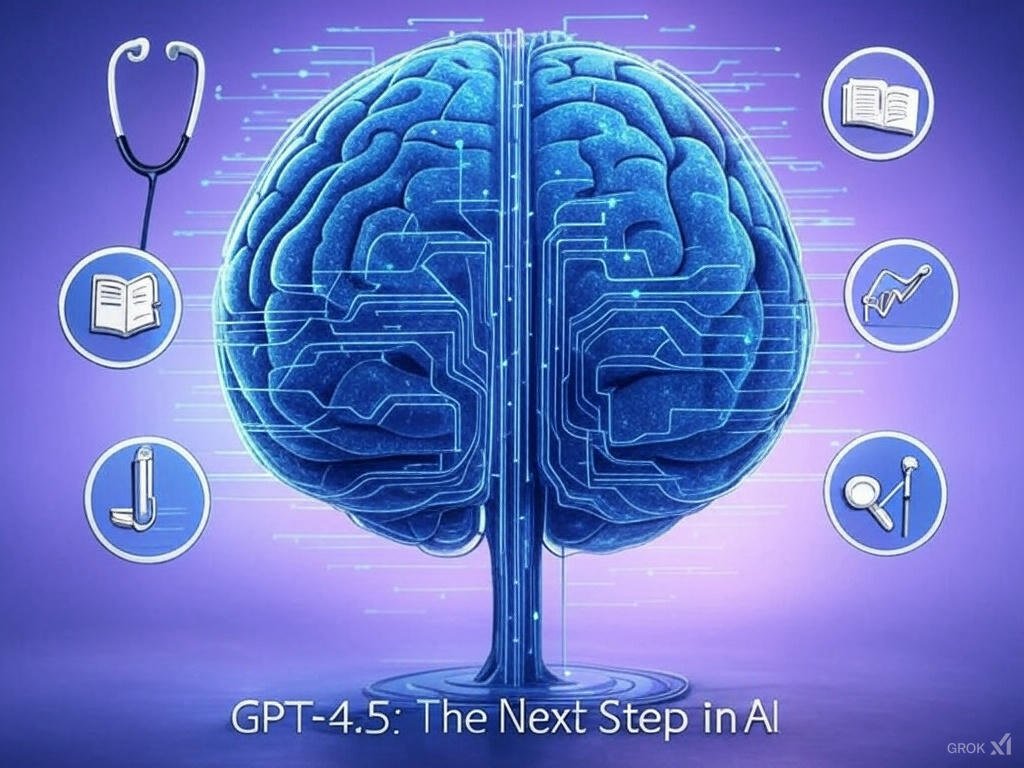Artificial intelligence (AI) continues to amaze us with its capabilities, and every new language model brings us closer to a future straight out of science fiction. In February 2025, OpenAI, the company behind ChatGPT and earlier GPT models, unveiled GPT-4.5—their latest creation that’s already generating buzz. What is GPT-4.5? How does it stack up against its predecessors, and what does it bring to the tech world? In this article, we’ll explore its key features, potential applications, challenges, and the road ahead—all in a way that’s easy to grasp for everyone.
What Is GPT-4.5, and How Does It Compare to Earlier GPT Models?
GPT-4.5 is the latest evolution in the family of Generative Pre-trained Transformer (GPT) models developed by OpenAI. Its predecessor, GPT-4, redefined how machines understand and generate text, introducing multimodal capabilities like image analysis. GPT-4.5 takes it a step further, blending a larger scale, improved precision, and a more natural conversational flow. OpenAI describes it as “the biggest and best conversational model” they’ve ever built.
Compared to GPT-4, GPT-4.5 boasts a broader knowledge base, better grasps user intent, and shows enhanced “emotional intelligence” (EQ). With a higher (though undisclosed) number of parameters, it picks up subtler patterns in data and delivers responses that feel even more human-like. It’s not just an upgrade—it also tackles some of GPT-4’s shortcomings, like “hallucinations,” where the AI occasionally generates false information.
Key Improvements and New Features
GPT-4.5 introduces several groundbreaking enhancements that set it apart. For starters, it excels at understanding context, making interactions smoother and more intuitive. “Early tests show conversations with GPT-4.5 feel more natural,” OpenAI claims, highlighting its ability to adapt to users in real time.
Another standout feature is its access to up-to-date information through integrated search capabilities. Unlike earlier models limited to a fixed dataset, GPT-4.5 can tap into the latest sources. It also supports file uploads and image processing, paving the way for complex tasks like document analysis or code generation from sketches. However, full multimodality—such as voice interaction or video analysis—remains absent for now.
Speed is another advantage. Optimized for efficiency, GPT-4.5 generates responses faster while using fewer computational resources. This benefits both individual users and businesses looking to integrate AI into their workflows.
Potential Applications of GPT-4.5
The possibilities with GPT-4.5 are nearly endless, and its versatility promises to impact numerous fields. In medicine, it could assist doctors by analyzing patient data, drafting reports, or accelerating drug discovery. Imagine a researcher uploading genetic sequencing results and GPT-4.5 suggesting potential treatment paths in seconds.
In education, GPT-4.5 could transform learning. “This model can tailor educational content to individual student needs,” says Dr. Rajesh Patel, an AI expert from India. Examples include personalized language lessons or simplifying complex math concepts.
Businesses stand to gain, too. Companies could use GPT-4.5 for customer service automation, marketing content creation, or market trend analysis. In the arts, creators are already experimenting with generative AI for writing scripts, composing music, or designing visuals—and GPT-4.5’s precision will only amplify these efforts.
Risks and Challenges
Such advanced AI doesn’t come without controversy. A major risk is disinformation. While hallucinations are reduced, GPT-4.5 can still produce convincing but false content, potentially fueling manipulation in the wrong hands. Dr. Aleksandra Przegalińska, a Polish AI researcher, warns, “Models like GPT-4.5 need strict oversight to prevent misuse.”
AI ethics is another concern. Who’s accountable for decisions made by the model? How do we ensure it doesn’t amplify biases in its training data? Then there’s the impact on jobs—automation could threaten roles in fields like copywriting or junior programming. Yet experts like Tomasz Trzciński argue, “Demand for experienced specialists will only grow.”
The Future of Language Models
What’s next after GPT-4.5? Experts predict that models like GPT-5 will push boundaries further, excelling in context understanding and multimodality. We might see integration with audio, video, or even augmented reality. “The future is unprecedented human-machine collaboration,” predicts Dr. Emily Richardson from MIT.
One potential direction is greater AI autonomy. Models could start generating their own training data, improving accuracy and reducing reliance on human-curated datasets. But striking a balance between innovation and responsibility will be key.
Breakthrough or Evolution?
Is GPT-4.5 a game-changer? Opinions vary. Its improvements—like fewer hallucinations and better interaction—are significant leaps. Yet the lack of full multimodality and reliance on existing architecture suggest it’s more of an evolution than a revolution. Dr. Piotr Sankowski from IDEAS NCBR notes, “It’s a solid step forward, but the real breakthrough will come when AI starts thinking independently, not just mimicking patterns.”
Availability and Costs
GPT-4.5 is rolling out in a “research preview” for ChatGPT Pro users, with broader access planned for Plus, Team, Enterprise, and Edu subscribers in the coming weeks. OpenAI’s phased approach allows for feedback and refinements. Pricing details are still under wraps, but given its enhanced capabilities, costs may exceed GPT-4’s, where API access starts at a few dollars per million tokens. GPT-4.5 might be pricier but promises better efficiency.
What Experts Are Saying
Experts agree GPT-4.5 is a milestone. “It’s another step in blurring the line between human and machine,” says Dr. Richardson. Analyst Ryan Gibson stresses regulation: “The potential is massive, but safety is critical.” Polish experts like Trzciński see it as both an opportunity for innovation and a challenge for the workforce.
Conclusion
GPT-4.5 is a model that blends impressive upgrades with the promise of more to come. Its applications in medicine, education, and business could reshape daily life, but it also raises questions about ethics and accountability. Is it a breakthrough? Perhaps not yet, but it’s a clear stride toward a future where AI becomes an indispensable partner. As Melvin Kranzberg once said, “Technology is neither good nor bad—nor is it neutral.” How we harness GPT-4.5’s potential is up to us.
This article is based on OpenAI announcements, expert opinions from academic sources, and analysis of AI trends.
